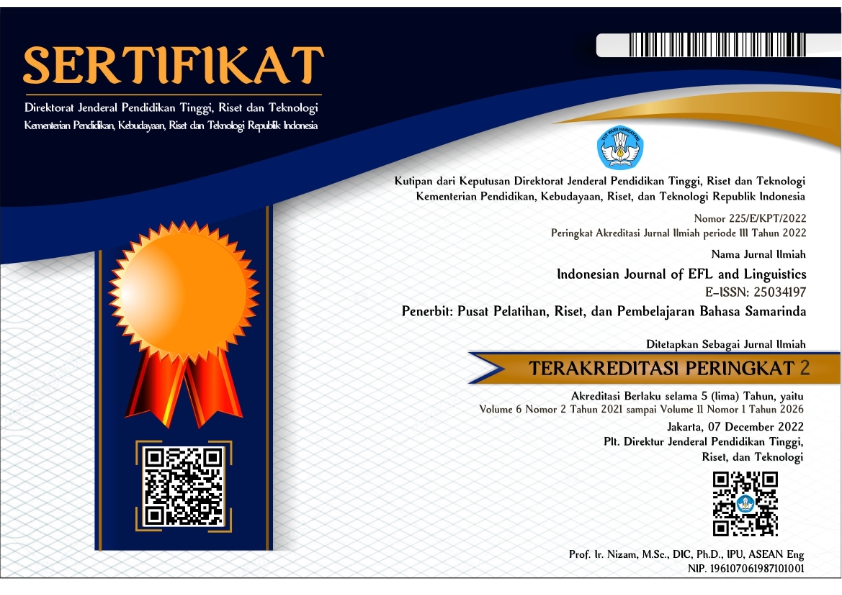Code Switching in Tetun Songs: The Way to Teach Language
Abstract
Nowadays, the use of language can be done through daily life conversations and in the form of works, one of which is a song. In connection with the function of language in social science, sociolinguistics was born, one of which is about code-switching. This research involves six popular songs from Timor Leste that use three language variations, namely Tetun, Indonesian, and English. As a result, three types of code-switching were found: tag switching, intra-sentential switching, and inter-sentential switching. From here, there are three functions of code-switching in these songs including proving that Tetun can be comparable to other languages, code-switching can be used to discuss certain topics, and finally, this phenomenon is also effective to show certain characteristics. The function of code-switching itself is also related to the language learning process for learners.
References
Barnard, R., Robinson, M., Costa, N., & Sarmento, J. (2011). Plurilingualism in University English Classes: A Case Study from Timor-Leste. Language Education in Asia, 2, 43–55. https://doi.org/10.5746/LEiA/11/V2/I1/A04/Barnard_Robinson_da_Costa_da_Silva_Sarmento
Borlongan, A. M. (2012). Reflecting on the Use of Code-Switching in Philippine Education Today. TESOL Journal, 7, 78–80.
Ezeh, N. G., Umeh, I. A., & Anyanwu, E. C. (2022). Code Switching and Code Mixing in Teaching and Learning of English as a Second Language: Building on Knowledge. English Language Teaching, 15(9), 106. https://doi.org/10.5539/elt.v15n9p106
Fukada, H. (2019). Ethnography of Communication Analysis in the Short Story of Romeo and Juliet. Education Journal, 2(3), 41. https://doi.org/10.31058/j.edu.2019.23002
Guterres, A., Gunawan, & Santoso, J. (2019). Stemming Bahasa Tetun Menggunakan Pendekatan Rule Based. Teknika, 8(2), 142–147. https://doi.org/10.34148/teknika.v8i2.224
Hoffmann, C. (2014). An introduction to bilingualism. Routledge.
Holmes, J., & Wilson, N. (2022). An introduction to sociolinguistics (Sixth edition). Routledge.
Hutauruk, B. S. (2016). Code Switching in Bilingual Classes: A Case Study of Three Lecturers at Bunda Mulia University.
Kadir, R. (2021). Code-Switching In Indonesian Popular Songs And The Implications For English Language Teaching. JOALL (Journal of Applied Linguistics and Literature), 6(1), 109–132. https://doi.org/10.33369/joall.v6i1.13314
Kridalaksana, H. (2013). Kamus Linguistik (4th ed.). Gramedia Pustaka Utama.
Memory, N. D., Nkengbeza, D., & Liswaniso, C. M. (2018). The Effects Of Code Switching On English Language Teaching And Learning At Two Schools In Sibbinda Circuit. International Journal of English Language Teaching, 6(5), 56–68.
Mutton, D., & Ciriello, R. F. (2022). English as a Language of Instruction in East Timor. https://doi.org/10.13140/RG.2.2.26030.59209
Poplack, S. (1980). “Sometimes I’ll Start a Sentence in Spanish Y TERMINO EN ESPANOLâ€: Toward a Typology of Code-Switching. Linguistic, 18(7), 581–618.
Saldıraner, G., & Cinkara, E. (2021). Using Songs in Teaching Pronunciation to Young EFL Learners. PASAA: Journal of Language Teaching and Learning in Thailand, 62, 119–141.
Sukmadinata, N. S. (2011). Metode Penelitian Pendidikan. Remaja Rosdakarya.
Thao, N. V. (2021). Code-Switching in Learning via Zoom Application: A Study in an EFL Context. 17(3).
Villalobos Ulate, N. (2008). Using Songs to Improve EFL Students’ Pronunciation. LETRAS, 44, 93–108. https://doi.org/10.15359/rl.2-44.5
Wardhaugh, R., & Fuller, J. M. (2015). An introduction to sociolinguistics (Seventh edition). Wiley Blackwell.
Williams-van Klinken, C., & Hajek, J. (2018). Language contact and functional expansion in Tetun Dili: The evolution of a new press register. Multilingua, 37(6), 613–647. https://doi.org/10.1515/multi-2017-0109
Yusuf, Y. Q., Fata, I. A., & -, C. (2018). Types of Indonesian-English code-switching employed in a novel. Kasetsart Journal of Social Sciences, 41(1), 208–213
Copyright (c) 2023 Indonesian Journal of EFL and Linguistics

This work is licensed under a Creative Commons Attribution-NonCommercial-ShareAlike 4.0 International License.




